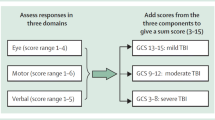Objective. To study the electroencephalographic signs of the early stages of emotional burnout syndrome (EBS). Materials and methods. Quantitative analysis of the electroencephalogram was carried out in 131 patients with EBS aged 25–45 years. The control group consisted of 143 healthy subjects. Results and conclusions. Patients at different stages of EBS showed increases in dysfunction of the regulatory systems of the brain corresponding to increases in the severity of the clinical signs of this disorder. This indicates an increase in the level of exhaustion of the regulatory systems of the brain and the formation of a stable pathological state.
Similar content being viewed by others
References
H. J. Freudenberger, “Staff burn-out,” J. Soc. Iss., 30, 159–166 (1974), https://doi.org/https://doi.org/10.1111/j.1540-4560.1974.tb00706.x.
L. N. Yur’eva, Work Burnout in Medical Workers: Formation, Prophylaxis, and Correction, Sfera, Kiev (2004).
V. V. Boiko, Methods for the Diagnosis of the Level of Emotional Burnout. Applied Psychodiagnosis, Samara (1999).
G. Van Luijtelaar, M. Verbraak, M. van den Bunt, et al., “EEG findings in burnout patients,” J. Neuropsychiatry Clin. Neurosci., 22, 208–217 (2010), https://doi.org/10.1176/jnp.2010.22.2.208.
K. Golonka, M. Gawlowska, J. Mojsa-Kaja, and T. Marek, “Psychophysiological characteristics of burnout syndrome: resting-state EEG analysis,” Biomed. Res. Int., 2019, 1–8 (2019), https://doi.org/https://doi.org/10.1155/2019/3764354.
O. G. Kondrat’eva and S. A. Bashkatov, “Changes in the EEG α rhythm on formation of emotional burnout syndrome in teachers in general schools,” Vestn. Chuvash. Gos. Pedagog. Univ. im. Yakovleva, 9, 263–271 (2010).
M. Fumoto, I. Sato-Suzuki, Y. Seki, et al., “Appearance of high-frequency alpha band with disappearance of low-frequency alpha band in EEG is produced during voluntary abdominal breathing in an eyes-closed condition,” Neurosci. Res., 3, 307–317 (2004), https://doi.org/10.1016/j.neures.2004.08.005.
M. A. Enoch, K. V. White, C. R. Harris, et al., “The relationship between two intermediate phenotypes for alcoholism: low voltage alpha EEG and low P300 ERP amplitude,” J. Stud. Alcohol, 63, No. 5, 509–517 (2002), https://doi.org/10.15288/jsa.2002.63.509.
H. C. Ossebaard, “Stress reduction by technology? An experimental study into the effects of brainmachines on burnout and state anxiety,” Appl. Psychophysiol. Biofeedback, 25, No. 2, 93–101 (2000), https://doi.org/https://doi.org/10.1023/a:1009514824951.
L. S. Chutko, A. V. Rozhkova, S. Yu. Surushkina, et al., “Clinical manifestations of emotional burnout syndrome,” Zh. Nevrol. Psikhiatr., 119, No. 1, 14–16 (2019), https://doi.org/10.17116/jnevro.201911901114.
N. P. Bekhtereva, D. K. Kambarova, and V. K. Pozdeev, Stable Pathological States in Brain Diseases, Meditsina, Leningrad (1978).
L. S. Chutko, S. Yu. Surushkina, E. A. Yakovenko, et al., “Efficacy of Cytoflavin in the treatment of emotional burnout syndrome,” Zh. Nevrol. Psikhiatr., 10, 66–70 (2015), https://doi.org/10.17116/jnevro201511510166-70.
A. I. Fedin, S. A. Rumyantseva, and O. R. Kuznetsov, “Efficacy of the neurometabolic protector Cytoflavin in cerebral infract,” Vestn. Sankt. Peterburg. Gos. Med. Akad. im. Mechnikova, 1, 13–19 (2005).
V. I. Chernii, G. A. Gorodnik, I. A. Andronova, and T. V. Chernii, “Use of quantitative electroencephalography in ranges reflecting neurotransmitter activity for assessment of the efficacy of neurometabolic therapy,” Mezhdunarod. Nevrol. Zh., 2, No. 88, 39–51 (2017).
S. A. Parfenov, V. G. Belov, and Yu. A. Parfenov, “Dynamics of measures of the functional state of the central nervous system in Navy crew members after a prolonged working cycle on the background of use of Cytoflavin,” Zh. Nevrol. Psikhiatr., 117, No. 8, 55–58 (2017), https://doi.org/10.17116/jnevro20171178155-58.
Author information
Authors and Affiliations
Corresponding author
Additional information
Translated from Zhurnal Nevrologii i Psikhiatrii imeni S. S. Korsakova, Vol. 120, No. 6, Iss. 1, pp. 32–35, June, 2020.
Rights and permissions
About this article
Cite this article
Yakovenko, E.A., Rem, A.V., Surushkina, S.Y. et al. Electroencephalographic Signs of Emotional Burnout Syndrome. Neurosci Behav Physi 51, 155–157 (2021). https://doi.org/10.1007/s11055-021-01051-z
Received:
Accepted:
Published:
Issue Date:
DOI: https://doi.org/10.1007/s11055-021-01051-z




